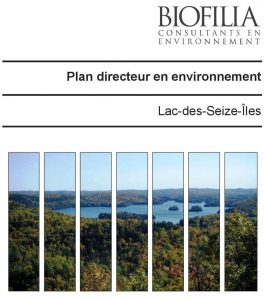Environmental Master Plan for the Lac-des-Seize-Iles
The Lac-des-Seize-Iles municipality remains, to this day, a jewel of the Laurentians.
It is to the citizens and their elected officials’ advantage to preserve this and to bet on an increased protection of their environment.
An environmental protection policy is, before anything else, a long-term vision of a healthy management of the territory.
The magnitude of this vision and the time necessary to attain it directly depend on the principles and convictions of the citizens and elected officials.
The protection of the environment and the enhancement of the territory encompass a variety of factors – political, actions and regulations – that enable the control the pressure put on the environmental receptors by the developments and their uses.
Awareness towards the importance of natural processes and the impact of actions is a key element of the success of an environmental policy.
To consult the environmental master plan go to the Studies section.
The municipality of Lac-des-Seize-Iles is a tranquil housing and resort environment, an aquatic and forestry surrounding with unbelievable landscapes that depend on the health and viability of its lakes and natural environments.
Bodies of water largely take up the municipality’s territory.
Beyond that and with the exception of a few developed sectors, a majority of the municipality’s watersheds are composed of forest environments.
The environmental master plan must establish the guidelines that will serve to protect this natural habitat.
This plan must maintain the integrity of the environment within the context of a strategic vision, of sustainable development and of the elaboration of the community’s urban plan.
The conversation plan realized by BIOFILIA in 2012 has characterized the landscape and the municipality’s natural components and has drawn a portrait of the ecosystems and the sensitive areas (ex: forests, elements associated to fauna, landscape elements, etc.) helping to elaborate a protection plan and of showcasing of our natural habitat.
The MAIN LINES of the environmental policy aim to:
- Preserve the integrity of the environment, landscape and heritage.
- Support the residential and resort vocation of the municipality.
- Maintain the visual quality of the borders along the transportation corridors, meaning that a harmonious integration of new developments within the natural environment is key.
- Heighten the citizens, administrators, municipal employees and elected officials’ awareness of the need for the preservation of natural environments and the impact of anthropic activities. (In geography and ecology, anthropization is defined as the transformation of spaces, landscapes, ecosystems or semi-natural areas under the influence of men. An area is considered ‘anthropized’ when it pulls away from its natural state).
- Document the ecosystems’ load capacity.
- Establish a concertation table for the watersheds of the Laurel Lake in order to facilitate the coordination of various panellists in the long-term protection of the municipality’s lakes (98% of the municipality’s surface area is part of the watershed of the Laurel lake)
- Integrate the water system classified by Biofilia within the graphic matrix in order to facilitate the decision making linked to the territory’s management.
- Update the normative provisions for the municipality’s urban regulation, all the while considering the natural and anthropic constraints in the development and management of the territory.
THEMES
The environmental policy of LDSI is split in five themes:
A. Protection of the hydrographic network
B. Protection of the forest network
C. Protection of biodiversity
D. Protection of the quality of life
E. Residual material management policies
OBJECTIVES :
1. PROTECTION OF THE HYDROGRAPHIC NETWORK
A. Protect the shores and coastline of the lakes, waterways and wetlands including the dispositions relating to the re-naturalization of the shores;
B. Monitor the quality of the lakes’ water;
C. Control the invading exotic species;
D. Control the flow of the waters towards the lakes and erosion;
E. Verify the sanitary installations and make them comply;
F. Prohibit the development of erosion prone areas;
G. Apply measure to control erosion in construction sites;
H. Make sure that there is a management of watersheds within the municipality.
2. PROTECTION OF GREEN SPACES AND FORESTS
A. Protect quality forest areas and assure their diversity;
B. Apply the by-law concerning the protected summits;
C. Govern the lots and implementations in order to guarantee the protection of the forested areas;
D. Control logging in order to avoid visual impacts and prevent any impact on the ecological balance, on the flora and fauna.
3. PROTECTION OF BIODIVERSITY
A. Preserve natural habitats;
B. Preserve biological corridors;
C. Recognize the presence of natural constraints (wetlands, biological corridors) and establish minimal distances to be respected during the development of projects near these areas.
4. PROTECTION OF THE QUALITY OF LIFE
A. Oversee the leisure and touristic activities in order to limit the impacts on natural environments and on the quality of life;
B. Support initiatives by lake organizations (code of ethics);
C. Protect the black sky;
D. Control noise pollution;
E. Bring awareness to the population in order to harmonize all the activities and to modify behaviours.
5. RESIDUAL MATERIALS
A. Maintain a position at the forefront of the best practices in the management of residual materials;
B. Encourage a change in behaviour that is more responsible from all actors in the community.
